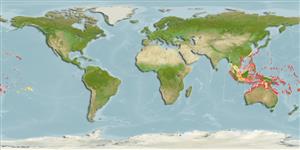>
Eupercaria/misc (Various families in series Eupercaria) >
Scaridae (Parrotfishes) > Scarinae
Etymology: Hipposcarus: Greek, ippos = horse + Latin, scarus = a fish cited by ancient writers; 1601 (Ref. 45335).
More on author: Valenciennes.
Environment: milieu / climate zone / depth range / distribution range
экология
морской ассоциированный с рифами; пределы глубины 0 - 40 m (Ref. 37816). Tropical; 30°N - 24°S, 95°E - 141°W
Pacific Ocean: Cocos-Keeling Islands and Rowley Shoals in the eastern Indian Ocean to the Line and Tuamoto islands, north to the Ryukyu Islands, south to the Great Barrier Reef and New Caledonia. Replaced by Hipposcarus harid in the Indian Ocean.
Size / Вес / Возраст
Maturity: Lm ? range ? - ? cm
Max length : 60.0 cm TL самец/пол неопределен; (Ref. 9710); common length : 48.0 cm SL самец/пол неопределен; (Ref. 37816)
колючие лучи спинного плавника (общее число) : 9; членистые (мягкие) лучи спинного плавника (общее число) : 10; колючие лучи анального плавника: 3; членистые (мягкие) лучи анального плавника: 9. Small juveniles are light brownish with a broad longitudinal orange band; the primary phase is a whitish brown to light gray with a yellowish tail; the terminal phase is light blue and green (Ref. 1602, 48636). Adults best recognized by the shape of the head (Ref. 48636).
Inhabits turbid lagoons more than outer reef areas. Usually seen in aggregations; females usually in small groups (Ref. 48636). Feeds on benthic algae (Ref. 89972). Minimum depth reported taken from Ref. 128797. Large adults may occur to depths of at least 40 m.
Life cycle and mating behavior
половая зрелость | размножение | нерест | икра | Fecundity | личинки
Oviparous, distinct pairing during breeding (Ref. 205).
Randall, J.E., G.R. Allen and R.C. Steene, 1990. Fishes of the Great Barrier Reef and Coral Sea. University of Hawaii Press, Honolulu, Hawaii. 506 p. (Ref. 2334)
Статус Красного Списка МСОП (Ref. 130435: Version 2024-1)
Угроза для людей
Reports of ciguatera poisoning (Ref. 130160)
Использование человеком
рыболовство: коммерческий
дополнительная информация
инструменты
Специальные отчеты
Скачать в формате XML
ресурсы в Интернет
Estimates based on models
Preferred temperature (Ref.
123201): 24.8 - 28.9, mean 27.7 °C (based on 518 cells).
Phylogenetic diversity index (Ref.
82804): PD
50 = 0.7500 [Uniqueness, from 0.5 = low to 2.0 = high].
Bayesian length-weight: a=0.01175 (0.00715 - 0.01930), b=3.03 (2.89 - 3.17), in cm total length, based on LWR estimates for this species & (Sub)family-body (Ref.
93245).
Trophic level (Ref.
69278): 2.0 ±0.1 se; based on diet studies.
устойчивость к внешним воздействиям (Ref.
120179): высокий, минимальное время удвоения популяции до 15 месяцев (K=0.5).
Fishing Vulnerability (Ref.
59153): Low to moderate vulnerability (27 of 100).
Nutrients (Ref.
124155): Calcium = 43.9 [25.2, 80.3] mg/100g; Iron = 0.713 [0.385, 1.197] mg/100g; Protein = 18.8 [16.7, 20.6] %; Omega3 = 0.0999 [, ] g/100g; Selenium = 42.2 [24.0, 80.9] μg/100g; VitaminA = 30.4 [9.0, 104.6] μg/100g; Zinc = 1.44 [0.99, 2.25] mg/100g (wet weight);
